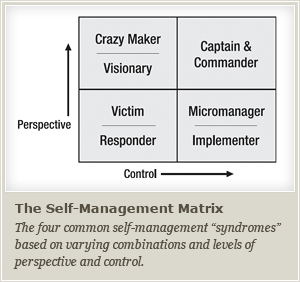If you lack the iron and the fizz to take control of your
own life, the gods will repay your weakness by having a grin or two at your
expense. Should you fail to pilot your own ship, don’t be surprised
what inappropriate port you find yourself docked.
—Tom Robbins
The two keys ingredients for
making it all work are:
- Control
- Perspective
If you can maintain a sufficient level of each of
these factors in yourself or in your organization, you probably won't find
much room for improvement. Your world will be in order and you’ll be
focused exactly as you should be. Only when one or both of them slip away from
optimal should you be concerned that something needs
righting.
Control and perspective are closely intertwined dynamics,
but achieving each one involves different approaches, whether the matter at
hand is your teenager doing homework, your soccer team’s practice,
your next vacation, or your product launch. If your kitchen is a mess, for
example, cleaning it up and placing all the tools and equipment where they
belong will be a very different exercise from deciding what to cook and how to
present it. But the two activities remain very connected, in that without an
organized kitchen, it will be very challenging to stay focused on the dinner
itself; likewise, an insufficient focus on the recipes, the various components
of the dinner event itself, and the plan for deploying them will allow the
situation to quickly get out of control again.
A matrix constructed on the axes of control and perspective
can be useful, both as a map for assessing your own standing with respect to
these elements (or that of another person or a particular situation) and as a
guide for improvement.
The four quadrants described by these axes identify, in very
general terms, the syndromes that are typically experienced with the varying
combinations of low and high control, and low and high perspective. The obvious
optimal state would be elevated levels of both — the sector that is
labeled “Captain and Commander.” Finding oneself in any of the other three quadrants, though, is
not necessarily a bad thing. Just as any high-performance vehicle frequently
gets off course, the best of us often fall away from the high-control, high-perspective state. It’s the nature of human experience, which is
always in some form of motion, to veer off course — sometimes in major,
but consistently in minor, ways.
If, however, you tend to spend too much time in one of the
less-than-optimal quadrants, you’ll probably deserve the negative
labels that are attached to them — Victim, Micromanager, or Crazy
Maker. But these labels are best used as warnings for a course correction, much
like the lane control bumps on a highway, when you drift as a result of your
exploration and forward motion. In such cases a positive aspect will more aptly
describe the syndromes — Responder, Implementer, and Visionary.
Adapted from "Making It All Work" by David Allen, by arrangement with Viking, a member of Penguin Group (USA) Inc.
